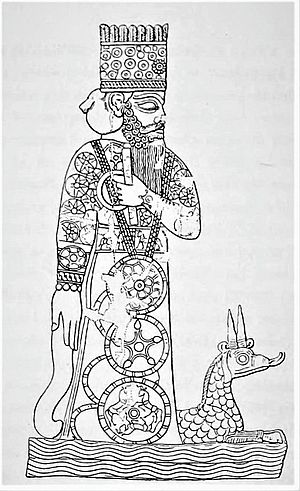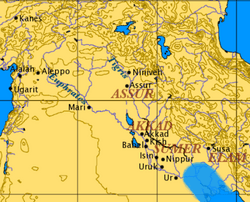Ancient Mesopotamian religion facts for kids
Mesopotamian religion was a set of beliefs and practices followed by people in ancient Mesopotamia. This area is mostly where modern Iraq is today. This religion was very important for about 3,500 years, until around 1 BCE.
Mesopotamian religion believed in many gods, which is called polytheism. There were over two thousand different gods! Many of these gods were linked to a specific city-state, like Sumer, Akkad, Assur, Nineveh, and Babylon. Some important gods included Anu, Ea, Enlil, Ishtar, Ashur, Shamash, and Marduk.
Some historians think Mesopotamian religion might be the world's oldest religion. We learn about it from things found by archaeologists in the region. Many stories and religious practices were written in cuneiform on clay tablets. Almost everything the Mesopotamians left behind helps us understand their religion, because it was a big part of their lives.
Contents
History of Mesopotamian Religion
The people of Mesopotamia were not one single group. They lived in many different city-states. The first signs of Mesopotamian religion appeared around 4000 BCE. At that time, the Sumerians lived in southern Mesopotamia, an area called Sumer. They had a big influence on the culture there. In the north, in a place called Akkad, the Akkadians developed their own culture. They spoke a different language from the Sumerians.
Over time, Sumerian and Akkadian cultures and their gods started to mix. The Akkadians often worshipped fewer gods but gave them more power. Around 2300 BCE, Sargon the Great, an Akkadian king, took control of all Mesopotamia. His empire lasted for about 200 years.
Later, around 1800 BCE, King Hammurabi of Babylon conquered much of Mesopotamia. But his Babylonian empire fell after about 100 years because of attacks from mountain people called the Kassites. After this, Mesopotamia was mostly split between two strong city-states: the Babylonians in the south and the Assyrians in the north. Eventually, in the 7th century BCE, Assyria was defeated.
In the 6th century BCE, the Persian empire, led by Cyrus the Great, invaded Mesopotamia. The Persians generally allowed the local culture and religion to continue. However, the Aramaic language started to become more common. Two centuries later, the Greek emperor Alexander the Great defeated the Persians and took over Mesopotamia. This marked the end of the ancient Mesopotamian era.
Mesopotamian Mythology
How the World Began (Cosmology)
We don't have many complete writings that explain how the Mesopotamians believed the world was created. But scholars have studied different stories to understand their ideas. The Epic of Creation, written around 1200 BCE, says that the god Marduk killed the mother goddess Tiamat. He used half of her body to make the Earth. The other half became the sky, called šamû, and the underworld, called irṣitu. Another old text from that time suggests the universe was like a ball. It had three levels of sky where the gods lived and stars shone, above three levels of Earth.
Gods and Goddesses
Mesopotamian religion was polytheistic, meaning people believed in many different gods and goddesses. They also practiced henotheism. This means that while they believed in many gods, people in a specific city or area might see one god as more important than others. For example, the god Enki was often linked to the city of Eridu, and Marduk was linked to Babylon.
We know about around 2,400 gods and goddesses from Mesopotamia. Most of them had Sumerian names. In the Sumerian language, gods were called dingir. In the Akkadian language, they were called ilu. The Sumerians and Akkadians often adopted each other's gods.
Mesopotamian gods were very much like humans. They were anthropomorphic, meaning they looked and often acted like people. They needed food and drink, and sometimes even drank alcohol. Many gods were related to each other, like a big family. Historians believe people saw the gods as powerful masters to be obeyed and respected, rather than loved. Still, many Mesopotamians, from all walks of life, named their children after certain gods. This practice started with the Sumerians and was later adopted by the Akkadians.
At first, there wasn't a clear order for the gods. But later, Mesopotamian thinkers started to rank them by importance. A Sumerian list from around 2600 BCE shows about 560 gods, with five main ones being most important. One of the most important early gods was Enlil. He was a Sumerian god seen as a king of the gods and controller of the world. The Akkadians later adopted him. Another important Sumerian god was An, who was similar to Enlil and became Anu to the Akkadians. The Sumerian god Enki was also adopted by the Akkadians, first by his original name, then as Éa. The Sumerian moon god Nanna became Sîn to the Akkadians, and the Sumerian sun god Utu became Šamaš. A very famous goddess was the Sumerian love deity Inanna, who was later known as Ištar by the Akkadians. When the Babylonians became powerful in the 18th century BCE, King Hammurabi made Marduk a very important god, placing him alongside Anu and Enlil.
Famous Stories (Legend)
Perhaps the most famous story from Mesopotamian religion is the Epic of Gilgamesh. It tells the tale of the brave king Gilgamesh and his wild friend Enkidu. Gilgamesh goes on a journey to find out how to live forever, and his quest involves many gods.
There are no known Mesopotamian stories about the end of the world. However, some people think they might have believed it would happen eventually. This idea comes from a writer named Berossus, who said Mesopotamians believed the world would last for a very long time, but not forever.
Life After Death (Afterlife)
Ancient Mesopotamians believed in an afterlife that was a land beneath our world. This land was called Arallû, Ganzer, or Irkallu, which meant "Great Below." They believed everyone went to this land after death, no matter who they were or what they did in life.
Religious Practices
Worship and Offerings
"Enlil! his power is great; his word is special and holy. His decisions cannot be changed; he decides what happens forever! His eyes watch the whole world!"
The Mesopotamians honored statues of their gods. They believed these statues actually held the spirit or personality of the god they represented. For example, in the poem How Erra Wrecked the World, the god Erra tricks Marduk into leaving his statue.
Many prayers from ancient Mesopotamia have been found. These prayers usually praise the god they are talking about above all others. These poems often show that people praised these gods out of respect and a little fear, rather than just joyful celebration.
Magic and Spells
People in Mesopotamian religion also believed in and practiced magic. In the city of Uruk, archaeologists found clay tablets from the 5th and 4th centuries BCE. These tablets had magical spells written on them.
Images for kids
See also
 In Spanish: Religión en Mesopotamia para niños
In Spanish: Religión en Mesopotamia para niños




